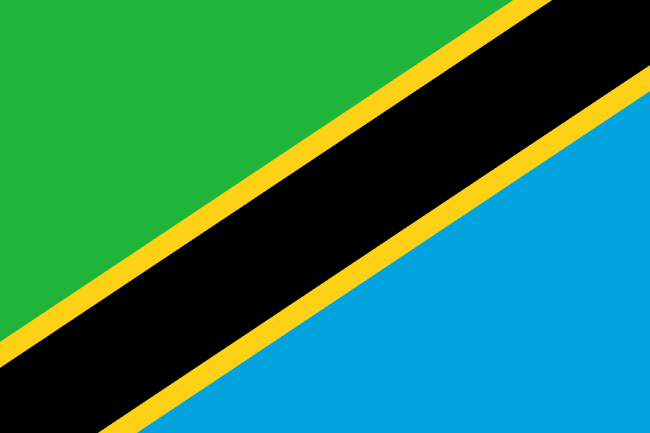Tanzania is an independent country in the Middle East of Africa and its border neighbors are Kenya and Uganda to the north, Rwanda, Burundi and the Democratic Republic of Congo to the west, Zambia, Malawi and Mozambique to the south.
The country has an area of approximately 945 thousand square kilometers and is the tenth-largest economy in Africa with an average of 45 billion dollars of GNP. The country has a population of over 50 million and has more than 130 ethnicities.
Tanzania is a unitary republic and consists of 20 regions called mikoa. Until 1996, Darussalam became the capital of the country. In 1996 Dodoma was declared the capital, and Darussalam was recognized as a trading city.
Tanzania – Turkey Relationship
Turkey embassy has been operating since 2009 in Tanzania. The Embassy of Tanzania was opened in 2017. The trade volume between Turkey and Tanzania is the US $ 122 million in 2016. (98.5 million from Turkey; 23.5 million from Tanzania)
Trade relations gained momentum with the opening of embassies and the launch of Turkish Airlines’ direct flights to Darussalam and Kilimanjaro. The amount of investment of Turkish citizens in Tanzania is approximately 40 million USD.
The Turkish Government provided scholarships to 29 Tanzanian students in this academic year.
Background at Tanzania
The country was dominated by Portugal and Omani Arabs between 1500-1880. It was colonized by the Germans in 1880-1919 and continued as a British colony from 1919 to 1961. After the independence of Tanganyika in 1961 and Zanzibar in 1963, these two countries united in 1964 and became known as Tanzania.
The first president, Julius Nyerere, who played a major role in gaining the independence of Tanzania, ruled the state until 1985.
Economical in Tanzania
Tanzanian economy is based on mining, agriculture, and tourism. Recently it has developed in the field of industry.
According to Tanzania National Bureau of Statistics, 41% of GNP comes from service, 29% from agriculture, 10% from tourism, 6% from manufacturing and 4% from the mining sector. Tanzania’s biggest trading partners are India, Kenya, South Africa, China, Saudi Arabia.
Our main export products are gold, cotton, coffee, tea, and cashew nuts; import products are petroleum and petroleum products, vehicles, machinery, and equipment.
Tanzania is Africa’s third-largest gold producer. Most of the resources such as natural gas, uranium, coal, and geothermal energy are still unprocessed due to the lack of processing facilities in the country.
General Informations of Tanzania
Climate: Tropical Climate.
Population: 55.5 Million
Ethnic Groups: Sukuma, Nyamwezi, Chagga, Haya, Hadza, Maasai
Languages: English, Swahili
Religions: Islam, Christianity
Natural Resources of Tanzania
Natural Gas, Gold, Diamond, Uranium, Nickel
Agricultural Products of Tanzania
Cotton, Coffee, Tea, Cashew
Industry in Tanzania
Gold ($ 1.55 billion), Coconut, Brazil Nut and Cashew (US $ 612 million), Raw Tobacco (US $ 344 million), Coffee (US $ 160 million) and Fish Fillets (US $ 157 million)
Exports Partners of Tanzania
India ($ 1.11 billion), South Africa ($ 709 million), China ($ 329 million), Vietnam ($ 314 million) and Switzerland ($ 275 million)
Imports – Partners of Tanzania
China ($ 1.69 billion), India ($ 1.2 billion), United Arab Emirates ($ 562 million), South Africa ($ 493 million) and Saudi Arabia ($ 441 million)
Currency of Tanzania
Tanzanian Shilling (TZS)
Energy in Tanzania
The ongoing development of Tanzania’s energy sector is critical to the economic growth of the country, attracting foreign direct investment and expanding its trade ties regionally and globally. Growth in power demand is between 10-15% per year.
Recent gas discoveries have quadrupled the known sources of Tanzania. A new gas pipeline from South Tanzania to Dar es Salaam was completed in late 2015. Previously, the country was producing expensive energy sources such as hydroelectric, diesel, heavy fuel or jet fuel. Today, however, natural gas accounts for approximately 58% of Tanzania’s electricity production.
Transport Sector in Tanzania
Tanzania’s transport sector increased by 55% in the 2009-2014 period from 1.3 billion USD to 2.1 billion USD.
The World Bank and the African Development Bank provide grants and loans for projects in Tanzania to improve infrastructure. According to Tanzania’s 2025 Development Vision, the government’s priority is to expand infrastructure and road network.
Urban Development in Tanzania
The urbanization rate increased to 33% in 2017. It is estimated that by 2045, half of the country’s population will settle in cities. The country organizes many programs for the healthy development of urbanization. The World Bank is providing assistance to the country for the development of urban development.
CENTER FOR AFRICAN STUDIES
Center for Africa Studies (AFRAM) which located in Ankara, is an organization facilitating under the administration of African Affairs Council (AFAC). It makes various researches about Africa to enhance economic and cultural bounds between Africa and Turkey. AFRAM’s publishings has been shared with different institutions as they require to obtain.
AFRICA OBSERVATORY
Africa Observatory is one the publishing of AFRAM and it has been published each two weeks. It has been delivered to different institutions via e-mail.
